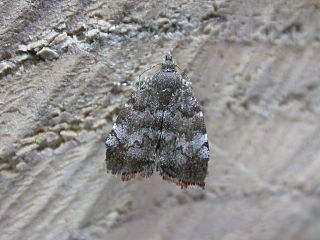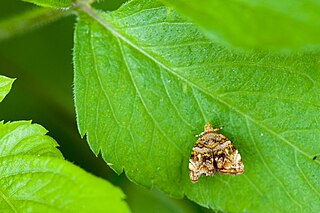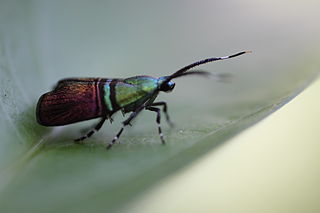
Choreutidae, or metalmark moths, are a family of insects in the lepidopteran order whose relationships have been long disputed. It was placed previously in the superfamily Yponomeutoidea in family Glyphipterigidae and in superfamily Sesioidea. It is now considered to represent its own superfamily. The relationship of the family to the other lineages in the group "Apoditrysia" need a new assessment, especially with new molecular data.

Anthophila fabriciana, also known as the common nettle-tap, is a moth of the family Choreutidae first described in 1767 by Carl Linnaeus. The moth can be found flying around stinging nettles during the day.

Tebenna micalis, also known as the small thistle moth, is a species of moth in the family Choreutidae found worldwide. It was first described by the German Bohemian entomologist, Joseph Johann Mann in 1857.

Prochoreutis myllerana, Miller’s nettle-tap or small metal-mark, is a moth of the family Choreutidae found in Asia and Europe. Miller's nettle-tap was first described by Johan Christian Fabricius in 1794 from a specimen found in Sweden.
Choreutis ophiosema is a species of moth of the family Choreutidae first described by Oswald Bertram Lower in 1896. It is found in India, Sri Lanka, China, Taiwan, Amoy, the Moluccas, eastern Australia and Japan.

Prochoreutis sestediana, also knowns as the silver-dot metal-mark is a moth of the family Choreutidae found in Asia and Europe. It was first described by Johan Christian Fabricius in 1776 from a specimen found in Kiel, Germany.
Choreutis cunuligera is a moth of the family Choreutidae. It is known from China and Japan (Honshu).
Choreutis achyrodes is a moth of the family Choreutidae. It is known from China, Japan, India (Assam) and the Oriental region.
Prochoreutis diakonoffi is a moth of the family Choreutidae. It is known from Shaanxi, China and from Honshu, Japan.
Prochoreutis holotoxa is a moth of the family Choreutidae. It is known from China (Shanxi), France (Alps), Italy, Austria (Tirol), Switzerland (Zermatt), Romania and Russia (Siberia).

Choreutis pariana, the apple-and-thorn skeletonizer or apple leaf skeletonizer, is a moth of the family Choreutidae. The moth was first described by the Swedish entomologist Carl Alexander Clerck in 1759. It is native to Eurasia and was introduced to New England, USA in 1917.

Prochoreutis solaris is a moth of the family Choreutidae. It is known from northern Europe, Russia, the Kuril Islands and Japan (Hokkaido).

Prochoreutis ultimana is a moth of the family Choreutidae. It is found from Sweden, Finland, the Baltic states and northern Russia to Japan.
Digitivalva sibirica is a moth of the family Acrolepiidae. It is found in China, Russia, Korea and Japan (Honshu).
Litobrenthia japonica is a moth in the family Choreutidae. It was described by Syuti Issiki in 1931. It is found in Japan and China (Zhejiang).
Choreutis atrosignata is a moth in the family Choreutidae. It was described by Hugo Theodor Christoph in 1888. It is found in the Russian Far East (Ussuri), Japan and China.

Choreutis hyligenes is a moth in the family Choreutidae. It was described by Arthur Gardiner Butler in 1879. It is found in China and Japan.
Prochoreutis subdelicata is a moth in the family Choreutidae. It was described by Yutaka Arita in 1987. It is found in Japan and Russia.

Saptha beryllitis is a moth in the family Choreutidae. It was described by Edward Meyrick in 1910. It is found on Japan, Taiwan, and India's Nicobar Islands.
Tebenna yamashitai is a moth in the family Choreutidae. It was described by Yutaka Arita in 1987. It is found in Japan.









